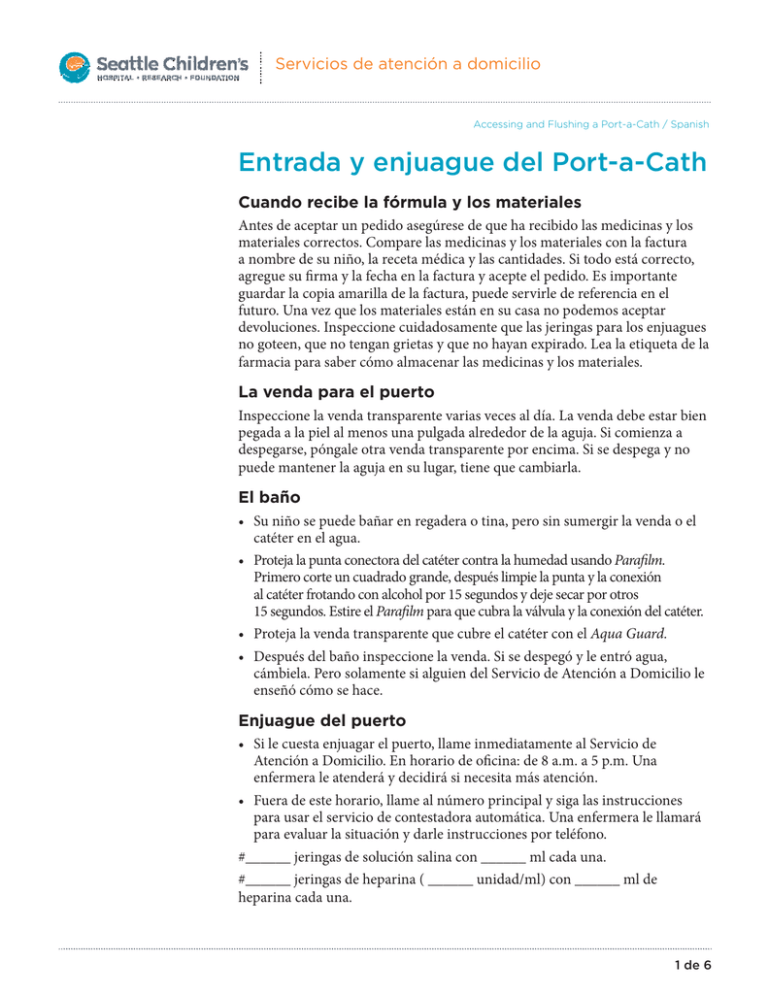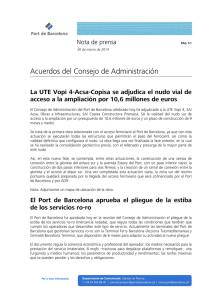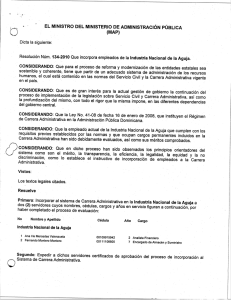PE1089 Accessing and Flushing a Port-a-Cath
Anuncio

Servicios de atención a domicilio Accessing and Flushing a Port-a-Cath / Spanish Entrada y enjuague del Port-a-Cath Cuando recibe la fórmula y los materiales Antes de aceptar un pedido asegúrese de que ha recibido las medicinas y los materiales correctos. Compare las medicinas y los materiales con la factura a nombre de su niño, la receta médica y las cantidades. Si todo está correcto, agregue su firma y la fecha en la factura y acepte el pedido. Es importante guardar la copia amarilla de la factura, puede servirle de referencia en el futuro. Una vez que los materiales están en su casa no podemos aceptar devoluciones. Inspeccione cuidadosamente que las jeringas para los enjuagues no goteen, que no tengan grietas y que no hayan expirado. Lea la etiqueta de la farmacia para saber cómo almacenar las medicinas y los materiales. La venda para el puerto Inspeccione la venda transparente varias veces al día. La venda debe estar bien pegada a la piel al menos una pulgada alrededor de la aguja. Si comienza a despegarse, póngale otra venda transparente por encima. Si se despega y no puede mantener la aguja en su lugar, tiene que cambiarla. El baño • Su niño se puede bañar en regadera o tina, pero sin sumergir la venda o el catéter en el agua. • Proteja la punta conectora del catéter contra la humedad usando Parafilm. Primero corte un cuadrado grande, después limpie la punta y la conexión al catéter frotando con alcohol por 15 segundos y deje secar por otros 15 segundos. Estire el Parafilm para que cubra la válvula y la conexión del catéter. • Proteja la venda transparente que cubre el catéter con el Aqua Guard. • Después del baño inspeccione la venda. Si se despegó y le entró agua, cámbiela. Pero solamente si alguien del Servicio de Atención a Domicilio le enseñó cómo se hace. Enjuague del puerto • Si le cuesta enjuagar el puerto, llame inmediatamente al Servicio de Atención a Domicilio. En horario de oficina: de 8 a.m. a 5 p.m. Una enfermera le atenderá y decidirá si necesita más atención. • Fuera de este horario, llame al número principal y siga las instrucciones para usar el servicio de contestadora automática. Una enfermera le llamará para evaluar la situación y darle instrucciones por teléfono. #______ jeringas de solución salina con ______ ml cada una. #______ jeringas de heparina ( ______ unidad/ml) con ______ ml de heparina cada una. 1 de 6 Entrada y enjuague del Port-a-Cath Jeringas para enjuague q q Jeringas de solución salina Jeringas azules de heparina de 10 unidades/ml Materiales Superficie de trabajo Producto de limpieza Gel desinfectante para manos Contenedor de objetos punzantes Paquete con Tegaderm grande materiales para cambiar la venda (abierto) Toallitas con alcohol Aquaguard Guantes no estériles Aguja de acceso al puerto (sin el envoltorio) Tapa del catéter MicroClave Parafilm 2 de 6 Entrada y enjuague del Port-a-Cath Preparación de la superficie de trabajo 1. Limpie bien la superficie con desinfectante y déjela que se seque sola al aire. 2. Lávese bien las manos con agua y jabón. 3. Reúna los materiales y colóquelos en un lugar limpio cerca del área de trabajo. 4. Abra el paquete que contiene los materiales para cambiar la venda. Tocando solo el borde, extienda el paño que envuelve los materiales, su interior le servirá como “campo estéril”. 5. Tome el sobre con los guantes estériles y colóquelos a un lado. 6. Abra y deje caer sobre el paño estéril el Biopatch, la válvula y la aguja de acceso al puerto. 7. Lávese las manos o use gel desinfectante y póngase los guantes estériles. 8. Conecte la jeringa de solución salina a la válvula del catéter y llénela con la solución salina. 9. Conecte la válvula del catéter, que tiene la jeringa ya conectada, a la punta de la sonda de la aguja de acceso al puerto. 10. Presione el émbolo llenando de solución salina la sonda hasta el final de la aguja. Limpieza alrededor del puerto 1. Abra el sobre de ChloraPrep que contiene tres cotonetes. 2. Frote la piel alrededor del puerto, 10 segundos con cada cotonete. 3. Déjela que se seque completamente al aire por un mínimo de 30 segundos. Acceso al puerto 1. Sostenga el puerto con una mano y encuentre el centro. 2. Con la otra mano sostenga la aguja e insértela en el centro, empujando hasta sentir que la aguja toca la pared posterior del puerto. 3. Jale el émbolo de la jeringa de solución salina para verificar que sale sangre. Si no sale sangre: • Cambie de posición: sentado, acostado, levantando el brazo del lado del puerto o volteando la cabeza hacia el lado opuesto al puerto e intente sacar sangre de nuevo. • Si aún así no sale sangre pero está seguro de que la aguja está colocada correctamente, inyecte lentamente la solución salina. Observe y palpe para ver si se hincha o hay molestias alrededor del acceso al puerto. • Si no está seguro de que la aguja entró en el puerto, retírela. Intente de nuevo con una nueva aguja y otro paquete de material estéril. 3 de 6 Entrada y enjuague del Port-a-Cath • Contacte a la enfermera del Servicio de Atención a Domicilio si tiene dificultad para acceder al puerto. 4. Después de verificar que sale sangre, enjuague el puerto con solución salina. 5. Si tiene que dejar la aguja de acceso, cúbrala con una venda transparente. Fíjela presionando desde el centro hacia los bordes. 6. Para administrar medicamentos o suero por vía intravenosa (IV), utilice las indicaciones que encontrará en el folleto SASH/SASASH. 7. Si solamente va a enjuagar: • Desconecte la jeringa con solución salina de la válvula del catéter. • Conecte la jeringa con heparina e inyecte el enjuague en un movimiento rápido. • Cierre la pinza del catéter. • Retire el acceso siguiendo las instrucciones en la siguiente sección. 8. Quítese los guantes y lávese las manos o use gel desinfectante. Para retirar el acceso al puerto 1. Retire la venda transparente vieja. 2. Sujete el puerto con una mano. 3. Con la otra mano presione las aletas de la aguja y retírela del puerto. 4. Aplique presión usando una gasa esterilizada. 5. Fíjese si está enrojecido, más inflamado de lo común o si supura y reporte cualquier cambio a su doctor. 6. Coloque una gaza con cinta en el lugar si no necesita acceder de nuevo. 7. Deseche la aguja usada en el contenedor de objetos punzantes. 8. Deseche los guantes y lávese las manos o use gel desinfectante. 4 de 6 Entrada y enjuague del Port-a-Cath Problemas y soluciones Problema Solución Enrojecimiento, supuración, inflamación o dolor en el área Tome la temperatura de su niño. Llame a Servicio de Atención a Domicilio. Venda despegada Los bordes de la venda pueden reforzarse recortando y pegando trozos de venda transparente sobre los bordes sueltos. Al menos ¾ de pulgada de la venda debe estar siempre adherida a la piel alrededor del centro de inserción del catéter. Protéjalo siempre de la humedad cubriéndolo antes de bañarse. Cámbiela enseguida si se despega, se ensucia o se moja. Llame al Servicio de Atención a Domicilio si tiene algún problema con la venda. Dificultad para enjuagar Verifique que la línea no esté doblada o que alguna pinza esté cerrada debajo de la gasa. Consulte la lista de consejos en la sección “Cómo coloco la aguja”… Llame al Servicio de Atención a Domicilio si no puede enjuagar la línea. Fugas y goteo Trate de enroscar bien la conexión a la entrada del catéter y luego enjuague prestando atención a que no haya fugas en la sonda ni en el área de acceso. Puede cambiarla por una aguja de acceso nueva. Llame al Servicio de Atención a Domicilio si continúa goteando. Reflujo sanguíneo en la línea Puede suceder cuando su niño aumenta la actividad física, no es una emergencia pero puede aumentar el riesgo de infección. Enjuague con la solución salina y la heparina pero no se exceda de la dosis máxima diaria. Si tiene dudas llame al Servicio de Atención a Domicilio. 5 de 6 Entrada y enjuague del Port-a-Cath A quién llamar • En caso de emergencia: llame al 911para CUALQUIER emergencia. Una vez que la situación se resuelva, notifique el estado de salud de su niño al Servicio de Atención en el Hogar. • Para asuntos urgentes después del hora de oficina, llame al Servicio de Atención en el Hogar al 425-482-4000 o al 800-888-4429 y presione 0 para conectarse con contestador si es urgente y no puede esperar hasta la mañana siguiente o si no está seguro de cómo proceder. Una enfermera del Servicio de Atención en el Hogar le devolverá la llamada tan pronto como sea posible. • Para pedir suministros: llame al Servicio de Atención en el Hogar entre las 8 a.m. y las 5 p.m. al 425-482-4000 o al 800-888-4429. Favor llamar al menos 1 semana antes de que se acaben los suministros. Tenga siempre suficientes suministros de repuesto para unos 3 a 5 días y 1 dosis de medicamento a la mano en caso de emergencia. Seattle Children’s ofrece servicios gratis de interpretación para pacientes, miembros de la familia y representantes legales sordos, con problemas de audición o con dominio limitado del inglés. Seattle Children’s pondrá a disposición esta información en formatos alternativos bajo solicitud. Por favor llame al Centro de recursos para las familias al 206-987-2201. Este volante fue revisado por personal clínico de Seattle Children’s. Sin embargo, las necesidades de su niño son únicas. Antes de actuar o depender de esta información, por favor consúltelo con el proveedor de atención médica de su niño. 4/15 PE1089 S © 2009, 2011, 2013, 2015 Seattle Children’s, Seattle, Washington. Derechos reservados. Servicios de atención a domicilio 6 de 6 Home Care Services Accessing and Flushing a Port-a-Cath Receiving medicine and supplies When you receive a shipment, make sure you have the correct medicine and supplies. Check the medicine/supplies and invoice for your child’s name, prescription and quantity. If all is correct, sign/date the invoice and accept the delivery. It is important to keep the yellow copy of your invoices for future reference. We are unable to take back any supplies once they are in your home. Carefully look at the flush syringes, checking for leaks, cracks and that it has not expired. See the pharmacy label for storage of medications and supplies. The Port dressing Check the dressing several times each day. Make sure the transparent dressing is stuck to the skin at least 1 inch around the needle. If the dressing is peeling up around the edges, reinforce by placing transparent dressing around these edges. If the dressing is loose and not able to keep the needle secure, you will need to change the dressing. Bathing • Your child can shower/bathe. However, do not submerge the catheter or dressing under water. • Protect the catheter cap from moisture by using Parafilm. Cut a large square. Scrub the cap and connection to the catheter with alcohol for 15 seconds, then let dry for 15 seconds. Stretch the Parafilm over the catheter cap and connection to the catheter hub. • Protect the catheter dressing by placing Aqua Guard over the dressing. • Inspect the dressing after bathing. If it is loose with water underneath, change the dressing. Only change the dressing if you have been trained by Home Care Services. Flushing the Port • If the Port seems difficult to flush, call Home Care immediately during business hours of 8 a.m. to 5 p.m. A nurse will talk with you and decide if further assessment is needed. • After normal hours, call our main number. Follow the prompts to access the answering service. A nurse will call back to assess the situation by phone and give instruction. #______ saline syringes with ______ ml of saline per syringe. #______ heparin ( ______ unit/ml) syringes with ______ ml of heparin per syringe. 1 of 5 Accessing and Flushing a Port-a-Cath Flush syringes q q Saline flush syringe Blue heparin flush syringe 10 units/ml Supplies Work surface or tray Cleaning product Alcohol-based hand gel Sharps container MicroClave catheter cap Dressing change Large tegaderm kit (open) Alcohol pads Aquaguard Non-sterile gloves Port needle (out of the package) Parafilm 2 of 5 Accessing and Flushing a Port-a-Cath Preparing the work surface 1. Clean the work surface well with disinfectant and allow to air dry. 2. Wash hands well with soap and water. 3. Gather supplies and place them in a clean spot near the work area. 4. Open the dressing change kit. Handling the edges only, carefully open the drape that covers the supplies. The inside of this wrapper will become the “sterile field.” 5. Remove the sterile gloves pack and set aside. 6. Open and drop the Biopatch, cap and Port needle onto the sterile drape. 7. Wash or gel hands. Put on sterile gloves. 8. Attach the saline syringe to the catheter cap. Fill the cap with saline. 9. Attach the catheter cap with the attached syringe to the end of the Port needle tubing. 10. Push the syringe plunger, filling the needle’s tubing with saline until it reaches the end of the needle. Cleaning the Port site 1. Open the ChloraPrep triple swab packet. 2. Scrub the Port site and surrounding skin with each swab stick for 10 seconds. 3. Allow the area to fully air dry for at least 30 seconds. Accessing the Port 1. With 1 hand, stabilize the Port and find the center of the Port chamber. 2. Hold the Port needle with your other hand. Insert the needle into the center of the Port, pushing until you feel the needle touch the back of the Port. 3. Pull back on the saline syringe, checking for blood return. If you are unable to get blood return: • Change positions. Sit up, lie down, raise the arm nearest to the Port over the head, turn the head to the side opposite the Port, then recheck for blood return. • If you are still unable to get good blood return, but certain the needle is in correctly, begin to flush slowly with saline. Watch and feel for swelling/discomfort around the access site. • If you are not certain the needle is in the Port, pull the needle out. Try again with a new needle and sterile setup. • Contact the Home Care Services nurse with difficulties accessing the Port. 4. After blood return, flush the Port with saline. 5. If the Port will remain accessed, cover with transparent dressing. Secure the dressing from the insertion site outward. 3 of 5 Accessing and Flushing a Port-a-Cath 6. If giving medicine/IV fluid, see the SASH/SASASH handout. 7. If flushing only: • Remove the saline syringe from the catheter cap. • Attach and flush briskly with the heparin syringe. • Clamp the catheter line. • De-access following the instructions below. 8. Remove gloves. Wash or gel hands. De-accessing the Port 1. Remove the old dressing. 2. Stabilize the Port with 1 hand. 3. With the other hand, pinch the wings and pull the Port needle out. 4. Use sterile gauze to apply pressure to the site. 5. Observe the site for redness, drainage or unusual swelling. Report anything new to your doctor. 6. Place gauze and tape on the site if re-access is not needed. 7. Place the used needle in the sharps container. 8. Remove gloves. Wash or gel hands. Troubleshooting chart Problem Solution Redness, drainage, swelling or pain at site Check your child’s temperature. Call Home Care Services. Dressing loosened Dressing edges may be reinforced by cutting pieces of a transparent dressing and placing along the edges that are loose. The dressing must always stick at least ¾ inch all the way around the insertion site of the catheter. Always protect it from moisture by covering it during bathing. Change it right away if it becomes loose, soiled or wet. Call Home Care Services if you are having difficulty with the dressing. 4 of 5 Accessing and Flushing a Port-a-Cath Problem Solution Difficulty flushing Observe the line for kinks and closed clamps in the tubing under the dressing. Try the ideas listed under the section, “How do I place the needle …” Call Home Care Services if you are still unable to flush the line. Leaking Attempt to tighten the catheter cap and then reflush, looking for leaks in the tubing or from the site. A new Port needle could be tried. Call Home Care Services if leaking continues. Blood back-up in line This can be related to increased activity in your child and is not an emergency; however, it can increase the risk for infection. Flush with saline and heparin. Do not flush more than your child’s daily maximum dosage of heparin. If you are unsure of what to do, please call Home Care Services. Who to call • For emergencies: Call 911 for ALL emergencies. Notify Home Care Services about your child’s status after the emergency situation is addressed. • For urgent issues after business hours Call Home Care Services at 425-482-4000 or 800-888-4429, and press “0” to reach our answering service for urgent issues that cannot wait until the morning or if you are unsure what to do. A Home Care Services nurse will return your call as soon as possible. • For supplies: Contact Home Care Services between 8 a.m. and 5 p.m. to order supplies. Call 425-482-4000 or 800-888-4429. Please contact us at least 1 week ahead so that you do not run out. Always keep an extra 3 to 5 days of supplies, and 1 dose of medication on hand in case of emergency. Seattle Children’s offers interpreter services for Deaf, hard of hearing or non-English speaking patients, family members and legal representatives free of charge. Seattle Children’s will make this information available in alternate formats upon request. Call the Family Resource Center at 206-987-2201. This handout has been reviewed by clinical staff at Seattle Children’s. However, your child’s needs are unique. Before you act or rely upon this information, please talk with your child’s healthcare provider. 4/15 PE1089 © 2009-2011, 2013, 2015 Seattle Children’s, Seattle, Washington. All rights reserved. Home Care Services 5 of 5


